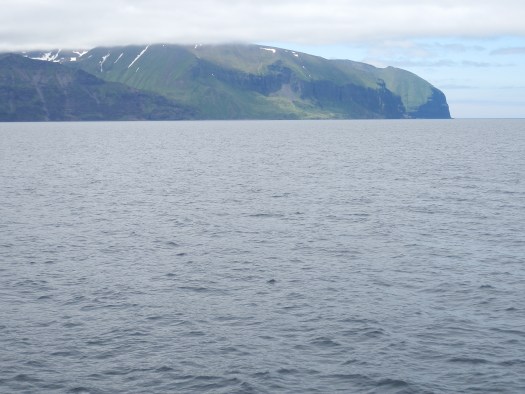NOAA Teacher at Sea
Lee Teevan
Aboard NOAA Ship Oscar Dyson
July 1 – 21, 2018
Mission: Acoustic Pollock-Trawl
Geographic Area of Cruise: East Bering Sea
Date: 2 July 2018
Weather Data from the Bridge
Latitude: 60 N
Longitude: 170W
Sea Wave Height: 2ft
Wind Speed: 18 knots
Wind Direction: 116 SE
Visibility: 7 miles
Air Temperature: 6.4°C
Barometric Pressure: 1028.1 mb
Sky: overcast

Science and Technology Log
Sailing on the East Bering Sea (EBS) may conjure images of a crew roughing it with just the basics. The captain in the image is steering with a large-spoked wooden wheel while those below sing sea shanties of longing, exploration and discovery.
Here on the Oscar Dyson, it’s a high-tech version of the cruises of days past. On our three-week cruise to track pollock migrations, we land-dwelling mammals have state-of-the-art equipment to assess the focus of our exploration. We have on-going acoustic surveys which show the movement of organisms around the boat. When we reach our first station later today, we will carry out a trawl and be able to see from 2 cameras on the trawl exactly which organisms are present around the station. From the trawl, we will evaluate the length and ages of pollock. There will be more to come on this aspect of the expedition after we reach our first station.
Science was also behind the protocol of our ship’s departure from Dutch Harbor, AK. Before leaving, the Oscar Dyson required at least 4 hours to fill its tank with 55, 000 gallons of diesel fuel. There are no pitstops along the way!

Blair Cahoon, the ship’s wiper, was onboard during the fueling of the ship. He explained the reasons for the boom, the 1-foot yellow floating barricade which prevents potential oil spills. Aboard the ship, white absorbent plastic was placed over fuels in case the tanks overfilled, and the gas splashed up. In addition, the marine chemist carried out fuel pump testing at certain increments.
After completely fueling the ship, the Oscar Dyson was untethered and set off through the Iliuliuk Bay, passing by pods of humpback whales and uninhabited islands.

As we left Dutch Harbor, I took in the receding landscape and welcomed the view of the water world which will be our home for the next three weeks. I thought of my fellow land-dwellers, past and present, who have sailed the EBS and imagined joining in their hearty renditions of sea shanties celebrating the exploration and discovery to come.
Personal Log
Before we reach our first station, I am acquainting myself with the labs and the procedures to be carried out. We also had down time during the ship’s transit to the initial station and I took many photos with several types of cameras. Two of my favorite cameras are the Holga medium format and my dependable Canon AE-1. The black and white photos I print from film are my attempt to capture stark beauty of the water around me.
Did You Know?
Filling up the gas tank of the Oscar Dyson costs more than $150, 000.00!
Animals Seen Today
Humpback whales
Puffins
Fulmars

